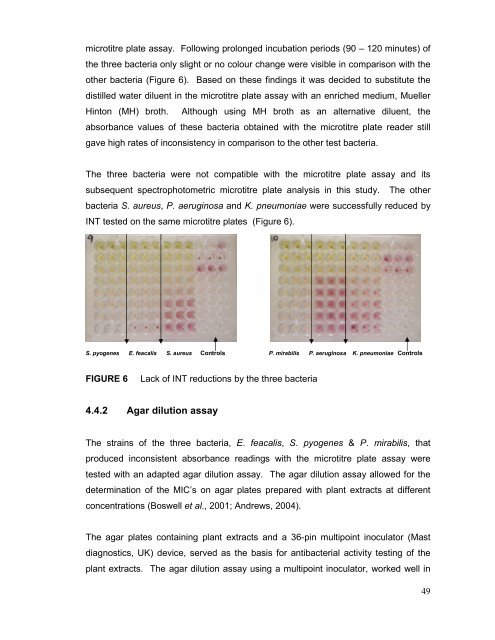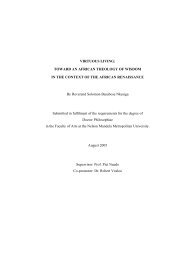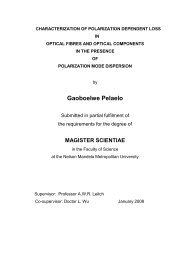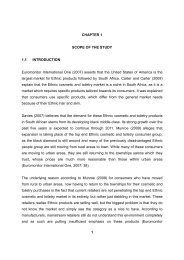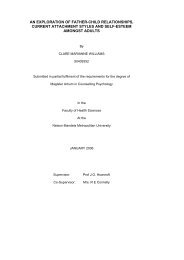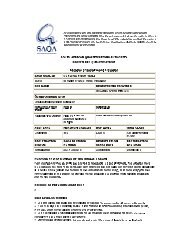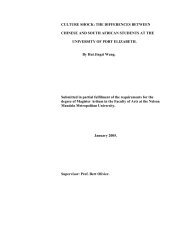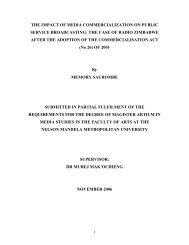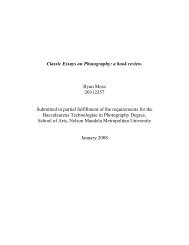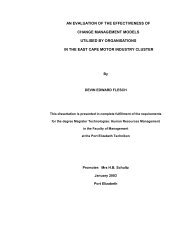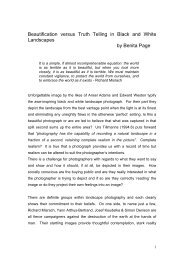an investigation into the antibacterial activities of medicinal plants ...
an investigation into the antibacterial activities of medicinal plants ...
an investigation into the antibacterial activities of medicinal plants ...
You also want an ePaper? Increase the reach of your titles
YUMPU automatically turns print PDFs into web optimized ePapers that Google loves.
microtitre plate assay. Following prolonged incubation periods (90 – 120 minutes) <strong>of</strong><br />
<strong>the</strong> three bacteria only slight or no colour ch<strong>an</strong>ge were visible in comparison with <strong>the</strong><br />
o<strong>the</strong>r bacteria (Figure 6). Based on <strong>the</strong>se findings it was decided to substitute <strong>the</strong><br />
distilled water diluent in <strong>the</strong> microtitre plate assay with <strong>an</strong> enriched medium, Mueller<br />
H<strong>into</strong>n (MH) broth. Although using MH broth as <strong>an</strong> alternative diluent, <strong>the</strong><br />
absorb<strong>an</strong>ce values <strong>of</strong> <strong>the</strong>se bacteria obtained with <strong>the</strong> microtitre plate reader still<br />
gave high rates <strong>of</strong> inconsistency in comparison to <strong>the</strong> o<strong>the</strong>r test bacteria.<br />
The three bacteria were not compatible with <strong>the</strong> microtitre plate assay <strong>an</strong>d its<br />
subsequent spectrophotometric microtitre plate <strong>an</strong>alysis in this study. The o<strong>the</strong>r<br />
bacteria S. aureus, P. aeruginosa <strong>an</strong>d K. pneumoniae were successfully reduced by<br />
INT tested on <strong>the</strong> same microtitre plates (Figure 6).<br />
S. pyogenes E. feacalis S. aureus Controls P. mirabilis P. aeruginosa K. pneumoniae Controls<br />
FIGURE 6<br />
Lack <strong>of</strong> INT reductions by <strong>the</strong> three bacteria<br />
4.4.2 Agar dilution assay<br />
The strains <strong>of</strong> <strong>the</strong> three bacteria, E. feacalis, S. pyogenes & P. mirabilis, that<br />
produced inconsistent absorb<strong>an</strong>ce readings with <strong>the</strong> microtitre plate assay were<br />
tested with <strong>an</strong> adapted agar dilution assay. The agar dilution assay allowed for <strong>the</strong><br />
determination <strong>of</strong> <strong>the</strong> MIC’s on agar plates prepared with pl<strong>an</strong>t extracts at different<br />
concentrations (Boswell et al., 2001; Andrews, 2004).<br />
The agar plates containing pl<strong>an</strong>t extracts <strong>an</strong>d a 36-pin multipoint inoculator (Mast<br />
diagnostics, UK) device, served as <strong>the</strong> basis for <strong>an</strong>tibacterial activity testing <strong>of</strong> <strong>the</strong><br />
pl<strong>an</strong>t extracts. The agar dilution assay using a multipoint inoculator, worked well in<br />
49


